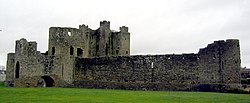Invasion of Ireland
In 1169 when Richard de Clare, 2nd Earl of Pembroke, nicknamed Strongbow, invaded Ireland on behalf of Henry II of England, Tyrrel accompanied him. [1] Strongbow and Tyrrel were 2nd cousins, great grandchildren of Richard fitz Gilbert de Clare. By 1172 he was described as one of the right-hand men of Hugh de Lacy, Lord of Meath, who conferred on him the feudal barony of Castleknock. He built Castleknock Castle, possibly on the site of an earlier fortification.
When de Lacy left Ireland to join the King in France, he made Tyrrel Constable of Trim Castle. In 1173 the Lordship of Meath was invaded by Ruaidrí Ua Conchobair, High King of Ireland, and Trim Castle was besieged. [2] A poet records Tyrrel's urgent appeal to Strongbow: "Through me the baron sends you word, Old Hugh Tyrrel of Trim, That you aid him in every way". [3]
Tyrrel was forced to evacuate Trim, but Ruaidrí soon withdrew and Tyrrel quickly reoccupied the castle and strengthened its defences; the same poet records: "Hugh Tyrrel went to Trim, And refortified his fortress, And safeguarded it with great honour". [1]

Despite their earlier friendship Tyrrel and de Lacy quarrelled in 1185: de Lacy accused Tyrrel of despoiling the monastery of Armagh and carrying away its valuables. Elrington Ball considers the accusation to be most unlikely, noting that Tyrrel was renowned as a benefactor, not a despoiler, of religious houses. In particular, he made a substantial grant of lands in present-day Phoenix Park to the Order of St. John of Jerusalem, whose Irish house was at Kilmainham. [3]